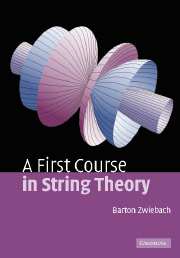Book contents
- Frontmatter
- Contents
- Foreword
- Preface
- Acknowledgements
- Part I Basics
- Part II Developments
- 14 D-branes and gauge fields
- 15 String charge, electric charge, and particle physics
- 16 String thermodynamics and black holes
- 17 T-duality of closed strings
- 18 T-duality of open strings
- 19 Electromagnetic fields on D-branes
- 20 Nonlinear and Born–Infeld electrodynamics
- 21 Covariant string quantization
- 22 String interactions and Riemann surfaces
- 23 Loop amplitudes in string theory
- References
- Index
15 - String charge, electric charge, and particle physics
from Part II - Developments
- Frontmatter
- Contents
- Foreword
- Preface
- Acknowledgements
- Part I Basics
- Part II Developments
- 14 D-branes and gauge fields
- 15 String charge, electric charge, and particle physics
- 16 String thermodynamics and black holes
- 17 T-duality of closed strings
- 18 T-duality of open strings
- 19 Electromagnetic fields on D-branes
- 20 Nonlinear and Born–Infeld electrodynamics
- 21 Covariant string quantization
- 22 String interactions and Riemann surfaces
- 23 Loop amplitudes in string theory
- References
- Index
Summary
If a point particle couples to the Maxwell field then that particle carries electric charge. Strings couple to the Kalb–Ramond field; therefore, strings carry a new kind of charge – string charge. For a stretched string, string charge can be visualized as a current flowing along the string. Strings can end on D-branes without violating conservation of string charge because the string endpoints carry electric charge and the resulting electric field lines on a D-brane carry string charge. Certain D-branes in superstring theory carry electric charge for Ramond–Ramond fields. If a charged brane is fully wrapped on a compact space, it appears to a lower-dimensional observer as a point particle carrying the electric charge of a Maxwell field that arises from dimensional reduction. Configurations of intersecting D6-branes in type IIA superstring theory define string models of particle physics that reproduce the full spectrum of gauge bosons and chiral fermions of the Standard Model.
Fundamental string charge
As we have seen before, a point particle can carry electric charge because there is an interaction which allows the particle to couple to a Maxwell field. The world-line of the point particle is one-dimensional and the Maxwell gauge field Aμ carries one index. This matching is important. The particle trajectory has a tangent vector dxμ(τ)/dτ, where τ parameterizes the world-line. Because it has one Lorentz index, the tangent vector can be multiplied by the gauge field Aμ to form a Lorentz scalar.
- Type
- Chapter
- Information
- A First Course in String Theory , pp. 307 - 351Publisher: Cambridge University PressPrint publication year: 2004



